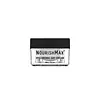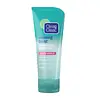What's inside
What's inside
 Key Ingredients
Key Ingredients

 Benefits
Benefits

 Concerns
Concerns

 Ingredients Side-by-side
Ingredients Side-by-side

Water
Skin ConditioningDimethicone
EmollientGlycerin
HumectantDimethicone/Vinyl Dimethicone Crosspolymer
Skin ConditioningPolyacrylamide
Cetearyl Olivate
Phenoxyethanol
PreservativeDimethiconol
EmollientSorbitan Olivate
EmulsifyingC13-14 Isoparaffin
EmollientParfum
MaskingDimethicone Crosspolymer
Emulsion StabilisingCarbomer
Emulsion StabilisingLaureth-7
EmulsifyingMethylparaben
PreservativePropylene Glycol
HumectantC12-14 Pareth-12
EmulsifyingPropylparaben
PreservativeEthylparaben
PreservativeCucumis Sativus Fruit Extract
EmollientMangifera Indica Fruit Extract
Skin ConditioningSodium Hydroxide
BufferingCamellia Sinensis Leaf Extract
AntimicrobialBlue 1 Lake
Cosmetic ColorantCI 19140
Cosmetic ColorantWater, Dimethicone, Glycerin, Dimethicone/Vinyl Dimethicone Crosspolymer, Polyacrylamide, Cetearyl Olivate, Phenoxyethanol, Dimethiconol, Sorbitan Olivate, C13-14 Isoparaffin, Parfum, Dimethicone Crosspolymer, Carbomer, Laureth-7, Methylparaben, Propylene Glycol, C12-14 Pareth-12, Propylparaben, Ethylparaben, Cucumis Sativus Fruit Extract, Mangifera Indica Fruit Extract, Sodium Hydroxide, Camellia Sinensis Leaf Extract, Blue 1 Lake, CI 19140
Ingredients Explained
These ingredients are found in both products.
Ingredients higher up in an ingredient list are typically present in a larger amount.
This ingredient is also known as "C13-14 Isoalkane".
C13-14 Isoparaffin is created from petroleum-based mineral oils. It is an emollient and helps thicken a product.
As an emollient, it helps keep the skin soft and smooth by creating a barrier on top. This barrier traps moisture in, keeping the skin hydrated.
C13-14 Isoparaffin may not be fungal-acne safe.
Learn more about C13-14 IsoparaffinLaureth-7 is created by the ethoxylation of lauryl alcohol using ethylene oxide. Lauryl alcohol is a fatty alcohol with hydrating properties.
This ingredient is an emulsifier and cleansing ingredient. As an emulsifier, it is used to prevent ingredients from separating. It also helps cleanse the skin by gathering dirt, oil, and pollutants to be rinsed away.
Phenoxyethanol is a preservative that has germicide, antimicrobial, and aromatic properties. Studies show that phenoxyethanol can prevent microbial growth. By itself, it has a scent that is similar to that of a rose.
It's often used in formulations along with Caprylyl Glycol to preserve the shelf life of products.
Polyacrylamide is a synthetic polymer. It is used to stabilize products and bind ingredients. When hydrated, Polyacrylamide forms a soft gel.
Polyacrylamide is low-toxicity. If source properly, it is deemed safe to use in cosmetics.
It should be noted the precursor to Polyacrylamide is acrylamide. Acrylamide is a carcinogen. Most reputable sources of Polyacrylamide will screen for residual acrylamide to make sure the count is in a safe range. Acrylamide is not able to be absorbed through the skin.
We recommend speaking with a professional if you have concerns.
Learn more about PolyacrylamideWater. It's the most common cosmetic ingredient of all. You'll usually see it at the top of ingredient lists, meaning that it makes up the largest part of the product.
So why is it so popular? Water most often acts as a solvent - this means that it helps dissolve other ingredients into the formulation.
You'll also recognize water as that liquid we all need to stay alive. If you see this, drink a glass of water. Stay hydrated!
Learn more about Water